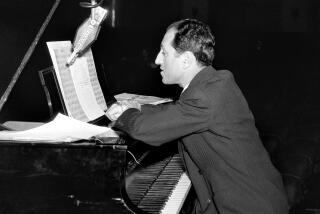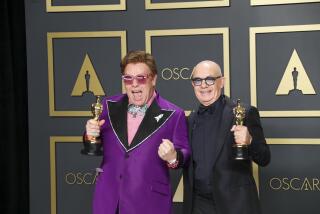Some Recordings That Got Rhythm
- Share via
Gershwin’s centennial comes with recordings, popular and classical, new and (repackaged) old. Three stand out, and Michael Tilson Thomas’ two-CD set, “George Gershwin: The 100th Birthday Celebration,” with the San Francisco Symphony, on BMG, most of all. MTT has become the de facto Gershwin birthday poster boy. He and his San Franciscans opened the Carnegie Hall season with this Gershwin program last week (it will be televised Wednesday on PBS). And that is just as it should be. Tilson Thomas grew up steeped in Gershwin. Gershwin cronies hung around his San Fernando Valley house when he was a kid (his father was a screenwriter, his grandparents legends of Yiddish theater). His highfalutin musical mentors--from Heifetz to Stravinsky to Bernstein--also happened to be Gershwin fanatics.
Yet neither Tilson Thomas’ Gershwin affinities nor his splendid work in San Francisco, are quite preparation for the magnificence of this new recording, which includes the “Catfish Row” Suite (along with a few added songs) from “Porgy and Bess”; the Second Rhapsody (with Tilson Thomas the solo pianist); “An American in Paris”; and the Concerto in F (with pianist Garrick Ohlsson). These are, all of them, ravishing performances. They are on the symphonic side, broad and sonically full, but there is also a sense of jazz phrasing that keeps them very agile. It’s the best of both worlds, and never has Gershwin sounded richer or deeper. Even the Piano Concerto and Second Rhapsody (not his most celebrated works) are, every moment, wondrous. The San Francisco Symphony plays as it never has before, and the soloists are terrific. If you buy only one Gershwin recording this season, the choice is a no-brainer.
If you must have a new “Rhapsody in Blue,” however, check out, as companion, Tilson Thomas’ “New World Jazz,” also on BMG. MTT is soloist and conductor in an exceptionally jazzy revel through Gershwin’s most famous work, which combines nicely on this CD with jazz-inspired classical pieces by John Adams, Leonard Bernstein, Stravinsky and others, all with Tilson Thomas’ lively training orchestra, the New World Symphony.
There are no new recordings of “Porgy and Bess” (and, curiously no important productions of it this season), but Sony has reissued the landmark 1951 studio recording, with Lawrence Winters and Camilla Williams as protagonists, in a gorgeous package that re-creates the original LP artwork. Almost complete, it is not only the first recording of “Porgy” to include the recitatives, it is also the first opera recording to attempt, with sound effects, to re-create the experience of opera-going at home. By modern standards both the singing style of the recitatives and the sonics sound clumsy. But there is a genuine soul to the singing, and a great momentum in Lehman Engel’s conducting. “Porgy” has never had a fully satisfying complete recording (what’s MTT waiting for?); this, faults and all, comes closest.
Another Gershwin landmark is the set of concert versions of five Broadway shows that Nonesuch Records produced between 1990 and 1995. Now, for the Gershwin year, it has made a single-disc sampler from the set, “Standards and Gems.” There are wonderful songs here in mostly wonderful performances. Some will take to Vicki Lewis’ flapperish rendition of “Barbary Coast” more than I, but it would require the coldest heart to resist Dawn Upshaw’s unfussy and utterly moving “Someone to Watch Over Me.” A treat: John Pizzarelli in “Fascinating Rhythm,” the kind of cut the repeat button was invented for.
Everyone, of course, wants into the Gershwin act, and that includes Joshua Bell, whose “Gershwin Fantasy,” on Sony, offers nearly an hour’s worth of the composer arranged for a virtuoso violinist. John Williams accompanies him, conducting the London Symphony and, in Heifetz’s arrangement of the Three Preludes, on the piano. Williams’ way with the music is easy and fluid. Bell has technique to burn, and shows it off well. The result is a nice recording of violin playing but one that tells us little about Gershwin. Elevators, however, could do worse.
More to Read
The biggest entertainment stories
Get our big stories about Hollywood, film, television, music, arts, culture and more right in your inbox as soon as they publish.
You may occasionally receive promotional content from the Los Angeles Times.











